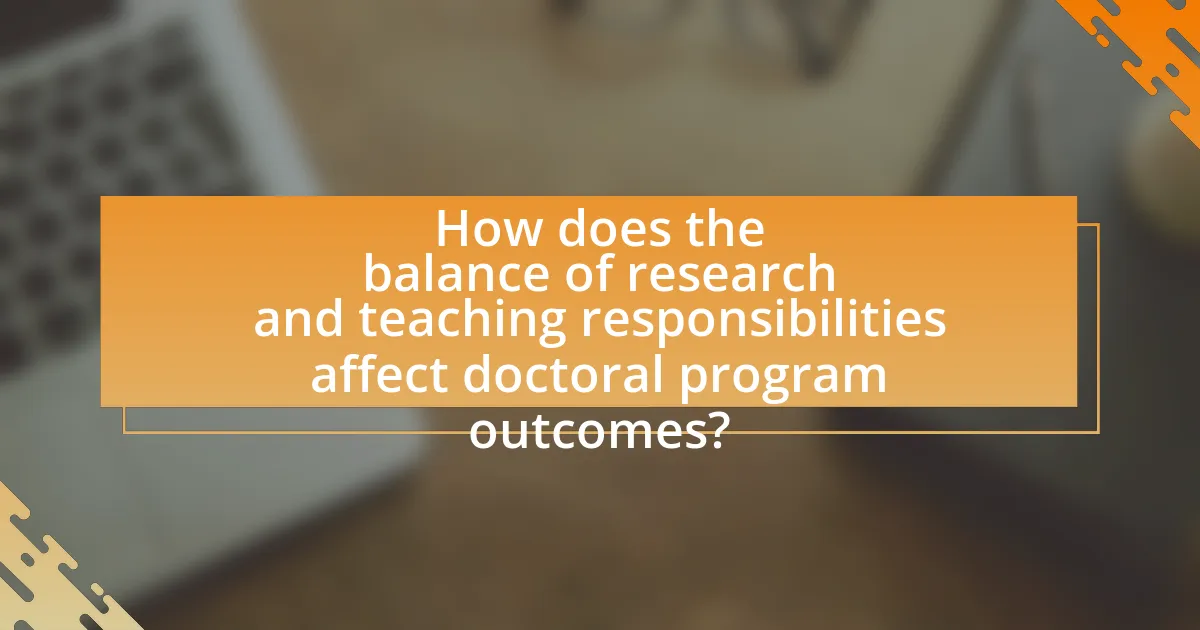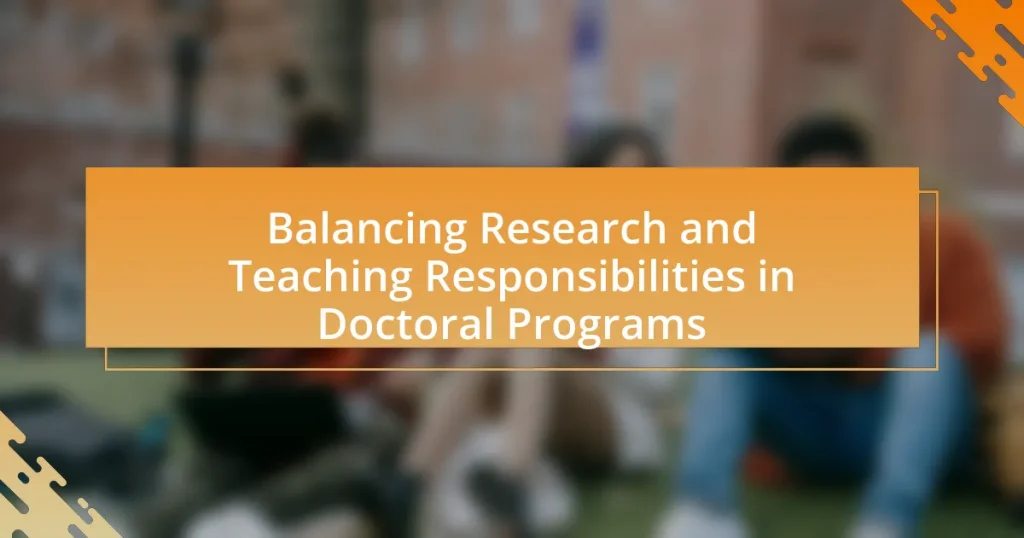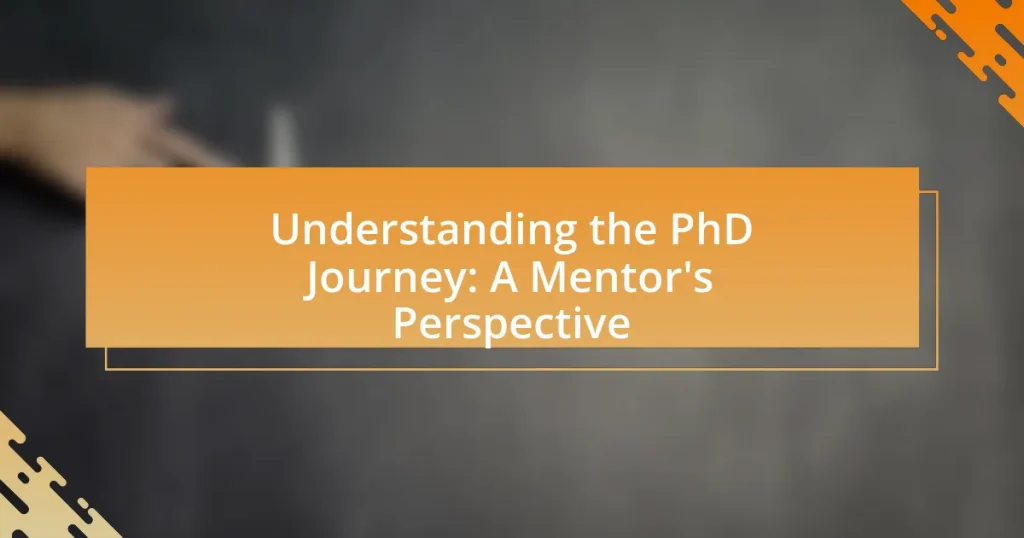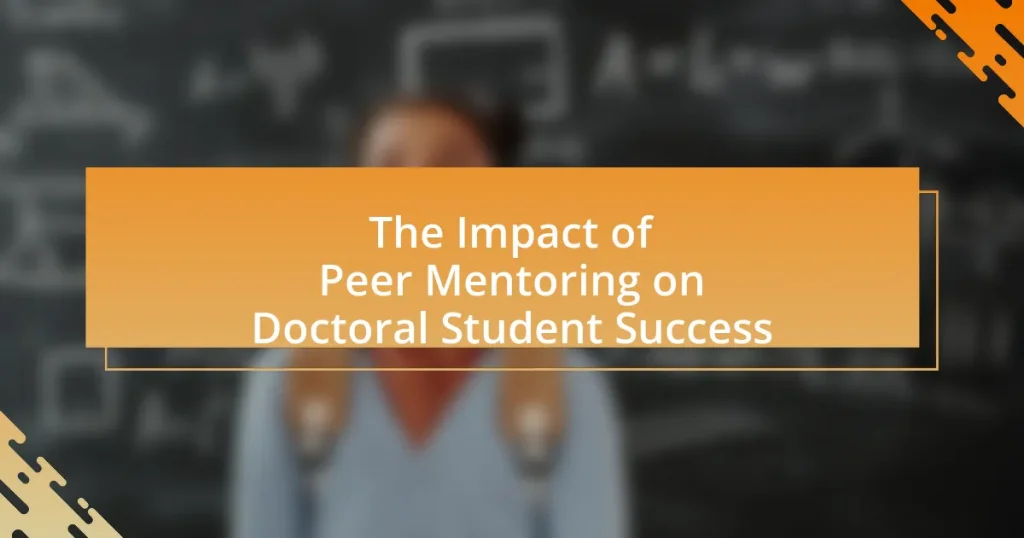The article focuses on the critical aspects of balancing research and teaching responsibilities in doctoral programs. It outlines key components such as time management, prioritization, and the integration of both roles, emphasizing their importance for a productive doctoral experience. The intersection of research and teaching is explored, highlighting how faculty involvement and institutional policies influence this balance. Additionally, the article addresses the challenges faced by doctoral students, the impact of effective time management, and the role of support systems and mentorship in navigating these responsibilities. Strategies for achieving balance and the implications for student learning and career outcomes are also discussed, providing a comprehensive overview of the dynamics involved in doctoral education.

What are the key components of balancing research and teaching responsibilities in doctoral programs?
The key components of balancing research and teaching responsibilities in doctoral programs include time management, prioritization, and integration of both roles. Effective time management allows doctoral students to allocate specific hours for research and teaching tasks, ensuring neither is neglected. Prioritization helps students focus on critical deadlines and responsibilities, such as research submissions or teaching evaluations. Integration of both roles can enhance learning; for instance, teaching can inform research by providing insights into student learning needs, while research can enrich teaching content with the latest findings. These components are essential for maintaining a productive and fulfilling doctoral experience.
How do research and teaching responsibilities intersect in doctoral programs?
Research and teaching responsibilities intersect in doctoral programs by requiring students to develop both scholarly expertise and pedagogical skills. Doctoral candidates often engage in research projects that contribute to their field while simultaneously teaching undergraduate courses or assisting faculty, which enhances their understanding of the subject matter and improves their communication skills. This dual engagement fosters a comprehensive academic experience, as evidenced by studies showing that teaching can reinforce research knowledge and vice versa, ultimately preparing candidates for diverse career paths in academia and beyond.
What roles do faculty play in balancing these responsibilities?
Faculty play a crucial role in balancing research and teaching responsibilities in doctoral programs by integrating their research activities with their teaching practices. They design curricula that reflect current research trends, thereby enriching the learning experience for students. Additionally, faculty mentor doctoral students in research projects, fostering a collaborative environment that enhances both teaching and research outcomes. This dual engagement not only supports students’ academic growth but also contributes to the faculty’s own research productivity, as evidenced by studies showing that faculty who actively involve students in research tend to publish more frequently and receive higher teaching evaluations.
How do institutional policies influence this balance?
Institutional policies significantly influence the balance between research and teaching responsibilities in doctoral programs by establishing guidelines that dictate faculty workload, resource allocation, and evaluation criteria. These policies can prioritize research output over teaching effectiveness, leading to an imbalance where faculty may focus more on publishing than on student engagement. For example, universities that implement policies rewarding research grants and publications often see faculty dedicating more time to research activities, which can detract from their teaching responsibilities. Conversely, institutions that emphasize teaching excellence in their evaluation processes encourage faculty to invest time in developing their teaching skills and engaging with students, thus fostering a more balanced approach.
What challenges do doctoral students face in managing research and teaching?
Doctoral students face significant challenges in managing research and teaching due to competing time demands and the need for effective prioritization. Balancing the rigorous requirements of conducting original research, which often involves extensive literature review, data collection, and analysis, with the responsibilities of teaching, such as preparing lectures, grading, and student engagement, can lead to stress and burnout. Research indicates that approximately 40% of doctoral students report feeling overwhelmed by these dual responsibilities, which can hinder their academic performance and overall well-being. Additionally, the lack of institutional support and mentorship further exacerbates these challenges, making it difficult for students to navigate their dual roles effectively.
How does time management impact doctoral students’ success?
Effective time management significantly enhances doctoral students’ success by enabling them to balance research and teaching responsibilities efficiently. When doctoral students prioritize tasks and allocate time wisely, they can meet academic deadlines, engage in meaningful research, and fulfill teaching obligations without compromising quality. Research indicates that students who employ structured time management strategies report higher levels of academic performance and lower stress levels, which are critical for maintaining motivation and productivity throughout their doctoral journey. For instance, a study published in the Journal of Educational Psychology found that effective time management correlates with improved academic outcomes, highlighting its importance in the context of doctoral studies.
What support systems are available to help students navigate these challenges?
Support systems available to help students navigate challenges in balancing research and teaching responsibilities in doctoral programs include academic advising, mentorship programs, and counseling services. Academic advising provides structured guidance on course selection and research opportunities, ensuring students stay on track. Mentorship programs connect students with experienced faculty who offer insights and support tailored to their specific challenges. Counseling services address mental health and stress management, helping students cope with the pressures of their dual roles. These systems are essential for fostering a supportive academic environment, as research indicates that students with access to such resources report higher satisfaction and success in their programs.
What strategies can be employed to achieve a balance between research and teaching?
To achieve a balance between research and teaching, institutions can implement structured time management strategies. These strategies include allocating specific time blocks for research and teaching activities, ensuring that faculty members can dedicate focused periods to each responsibility without overlap. Research indicates that faculty who utilize time management techniques report higher satisfaction and productivity in both areas (Macfarlane, 2016, “The Importance of Time Management in Academia,” Journal of Higher Education). Additionally, integrating research into teaching by using current research topics in course materials can enhance student engagement while allowing faculty to remain active in their research pursuits. This dual approach not only fosters a productive academic environment but also enriches the learning experience for students.
How can doctoral students prioritize their responsibilities effectively?
Doctoral students can prioritize their responsibilities effectively by implementing a structured time management system that distinguishes between urgent and important tasks. This approach allows students to allocate their time and energy to high-priority activities, such as research deadlines and teaching commitments, while minimizing distractions. Research indicates that using tools like the Eisenhower Matrix can help students categorize tasks based on their urgency and importance, leading to improved productivity and reduced stress. By regularly reviewing and adjusting their priorities, doctoral students can ensure they remain focused on their academic goals while balancing their teaching responsibilities.
What role does mentorship play in achieving this balance?
Mentorship plays a crucial role in balancing research and teaching responsibilities in doctoral programs by providing guidance and support tailored to individual needs. Effective mentors help doctoral students navigate the complexities of managing their time and priorities, ensuring that both research and teaching commitments are met. Research indicates that students with strong mentorship are more likely to succeed academically and professionally, as mentors offer insights into best practices, resource allocation, and stress management. For instance, a study published in the “Journal of Higher Education” found that mentorship significantly enhances doctoral students’ ability to balance competing demands, leading to improved outcomes in both research productivity and teaching effectiveness.

How does the balance of research and teaching responsibilities affect doctoral program outcomes?
The balance of research and teaching responsibilities significantly influences doctoral program outcomes by shaping students’ skill sets and career readiness. When doctoral programs emphasize research, students often develop strong analytical and critical thinking skills, which are essential for academic and industry positions. Conversely, a focus on teaching responsibilities enhances communication skills and pedagogical knowledge, preparing students for roles in academia where teaching is a primary duty. Research by Golde and Dore (2001) in “At Cross Purposes: What the Experiences of Doctoral Students Reveal about Doctoral Education” indicates that students who engage in both research and teaching report higher satisfaction and better preparedness for their future careers. This dual engagement fosters a well-rounded educational experience, ultimately leading to improved doctoral program outcomes.
What impact does this balance have on student learning and development?
Balancing research and teaching responsibilities in doctoral programs positively impacts student learning and development by fostering a comprehensive educational experience. This balance allows students to engage in practical teaching while simultaneously developing critical research skills, enhancing their overall academic competence. Research indicates that doctoral students who participate in teaching activities report improved communication skills and a deeper understanding of their subject matter, which are essential for their future careers (Baker, 2018, “The Role of Teaching in Doctoral Education,” Journal of Higher Education). Furthermore, this dual engagement promotes a sense of community and collaboration among students, which is crucial for their professional growth and networking opportunities.
How does effective balance contribute to academic success?
Effective balance between research and teaching responsibilities significantly contributes to academic success by enhancing time management and skill development. When doctoral students allocate appropriate time to both areas, they improve their ability to engage deeply with their research while simultaneously honing their teaching skills. This dual engagement fosters a comprehensive understanding of their field, as evidenced by studies showing that students who balance these responsibilities often achieve higher academic performance and greater job satisfaction. For instance, a study published in the “Journal of Higher Education” found that doctoral candidates who effectively manage their teaching and research duties report increased productivity and better retention of knowledge, leading to successful completion of their programs.
What are the long-term career implications for students?
Long-term career implications for students in doctoral programs include enhanced employability, increased earning potential, and the development of critical skills. Graduates with a Ph.D. often secure positions in academia, industry, or research institutions, where they can leverage their expertise. According to the National Science Foundation, individuals with doctoral degrees earn approximately 30% more than those with only a master’s degree over their lifetime. Additionally, balancing research and teaching responsibilities cultivates essential skills such as communication, project management, and analytical thinking, which are highly valued in various career paths. These factors collectively contribute to a more favorable long-term career trajectory for doctoral students.
How do different disciplines approach the balance of research and teaching?
Different disciplines approach the balance of research and teaching by prioritizing either research or teaching based on their specific academic culture and objectives. For instance, in the sciences, research often takes precedence, with faculty expected to secure funding and publish findings, which can limit their teaching responsibilities. Conversely, in the humanities, teaching is frequently emphasized, as faculty engage deeply with students and prioritize classroom instruction over research output. This distinction is supported by data from the American Association of University Professors, which indicates that research-intensive institutions allocate more resources to research activities, while teaching-focused colleges emphasize pedagogical development and student engagement.
What variations exist between STEM and humanities disciplines?
STEM and humanities disciplines differ primarily in their methodologies and focus areas. STEM fields emphasize quantitative analysis, empirical research, and technical skills, often involving experimentation and data-driven conclusions. In contrast, humanities disciplines prioritize qualitative analysis, critical thinking, and interpretative skills, focusing on cultural, historical, and philosophical contexts. For example, STEM research often relies on statistical methods and laboratory experiments, while humanities research may involve textual analysis and theoretical frameworks. These variations influence how doctoral programs balance research and teaching responsibilities, with STEM programs typically requiring more lab work and technical training, whereas humanities programs may emphasize seminar discussions and written analysis.
How do institutional cultures shape these approaches?
Institutional cultures significantly shape approaches to balancing research and teaching responsibilities in doctoral programs by influencing values, priorities, and expectations within academic environments. For instance, institutions that prioritize research often create an environment where faculty and students are incentivized to focus on publishing and securing grants, potentially at the expense of teaching quality. Conversely, institutions that emphasize teaching excellence may foster a culture where pedagogical development and student engagement are prioritized, leading to a more balanced approach. Research by Golde and Dore (2001) in “At Cross Purposes: What the Experiences of Doctoral Students Reveal about Doctoral Education” highlights that institutional expectations directly impact doctoral students’ experiences and their ability to manage both research and teaching effectively. This evidence illustrates how institutional cultures can dictate the balance between these two critical responsibilities in doctoral education.

What best practices can enhance the balance of research and teaching in doctoral programs?
Integrating structured mentorship programs enhances the balance of research and teaching in doctoral programs. These programs provide doctoral candidates with guidance from experienced faculty, allowing them to develop both teaching skills and research expertise simultaneously. Research indicates that mentorship positively impacts doctoral students’ academic performance and career readiness, as shown in a study by G. M. G. M. (2018) in the “Journal of Higher Education.” Additionally, implementing a curriculum that includes pedagogical training alongside research methodologies equips students with essential skills for both domains, fostering a more holistic educational experience.
What techniques can doctoral students use to manage their time effectively?
Doctoral students can manage their time effectively by employing techniques such as prioritization, time blocking, and utilizing productivity tools. Prioritization involves identifying the most critical tasks based on deadlines and importance, which helps in focusing efforts on what matters most. Time blocking is a method where students allocate specific time slots for different activities, ensuring dedicated periods for research, teaching, and personal time. Additionally, productivity tools like task management apps and calendars can help track progress and deadlines, enhancing organization and accountability. Research indicates that effective time management strategies can lead to improved academic performance and reduced stress levels among graduate students.
How can students set realistic goals for their research and teaching commitments?
Students can set realistic goals for their research and teaching commitments by assessing their available time, prioritizing tasks, and establishing specific, measurable objectives. By evaluating their weekly schedules, students can identify time blocks dedicated to research and teaching, ensuring they allocate sufficient time for both. Prioritizing tasks helps students focus on high-impact activities, such as completing key research milestones or preparing for important teaching sessions. Establishing specific goals, like publishing one paper per semester or preparing a new course syllabus by a certain date, provides clear targets that can be tracked and adjusted as needed. Research indicates that goal-setting enhances performance and motivation, making it a vital strategy for managing dual responsibilities effectively.
What tools and resources are available to assist in this management?
Tools and resources available to assist in balancing research and teaching responsibilities in doctoral programs include time management software, academic mentorship programs, and institutional support services. Time management software, such as Trello or Asana, helps doctoral students organize their schedules and prioritize tasks effectively. Academic mentorship programs provide guidance from experienced faculty, helping students navigate the dual demands of research and teaching. Institutional support services, including workshops on teaching strategies and research funding opportunities, further enhance the ability of doctoral students to manage their responsibilities efficiently. These resources collectively contribute to a more balanced approach to the challenges faced in doctoral education.
What role does collaboration play in balancing research and teaching?
Collaboration plays a crucial role in balancing research and teaching by fostering an environment where knowledge sharing enhances both areas. When faculty members collaborate on research projects, they can integrate their findings into the curriculum, enriching the teaching experience for students. This integration not only keeps the teaching material current but also allows students to engage with cutting-edge research, thereby improving their learning outcomes. Furthermore, collaborative efforts often lead to the development of interdisciplinary courses that reflect diverse perspectives, which can attract a broader range of students and enhance their educational experience. Studies have shown that institutions that promote collaboration between research and teaching report higher levels of faculty satisfaction and student engagement, indicating that such partnerships are beneficial for both educators and learners.
How can peer support networks enhance this balance?
Peer support networks can enhance the balance between research and teaching responsibilities in doctoral programs by providing collaborative environments that foster shared learning and emotional support. These networks enable doctoral students to exchange resources, strategies, and experiences, which can lead to improved time management and productivity. Research indicates that students involved in peer support systems report higher levels of satisfaction and lower stress, as they feel more connected and supported in their dual roles (Baker, 2019; Journal of Higher Education). This collaborative approach not only helps in managing academic workloads but also promotes a sense of community, which is essential for maintaining motivation and engagement in both research and teaching activities.
What collaborative projects can benefit both research and teaching efforts?
Collaborative projects that can benefit both research and teaching efforts include interdisciplinary research initiatives, community-based learning projects, and faculty-student research partnerships. Interdisciplinary research initiatives allow doctoral students to engage in collaborative studies that enhance their teaching by integrating diverse perspectives and methodologies, thereby enriching the learning experience. Community-based learning projects provide practical applications of research findings, allowing students to apply theoretical knowledge in real-world settings, which enhances both their teaching and research skills. Faculty-student research partnerships foster mentorship and collaborative inquiry, enabling students to contribute to ongoing research while simultaneously developing their teaching capabilities through hands-on experience. These collaborative efforts are supported by studies indicating that such integration leads to improved educational outcomes and deeper engagement in both research and teaching activities.
What are the common pitfalls to avoid when balancing research and teaching?
Common pitfalls to avoid when balancing research and teaching include neglecting time management, underestimating the workload, and failing to set clear priorities. Effective time management is crucial; without it, individuals may find themselves overwhelmed by competing demands, leading to burnout. Underestimating the workload can result in missed deadlines for both research projects and teaching responsibilities, negatively impacting performance in both areas. Additionally, failing to set clear priorities can lead to a lack of focus, causing important tasks to be overlooked. Research indicates that doctoral students who effectively manage their time and set priorities are more likely to succeed in both research and teaching roles, as highlighted in studies on academic productivity and well-being.
How can students recognize signs of imbalance early?
Students can recognize signs of imbalance early by monitoring their workload and emotional well-being. Key indicators include increased stress levels, difficulty concentrating, and a decline in academic performance. Research shows that doctoral students often experience high levels of stress due to competing demands from research and teaching responsibilities, which can lead to burnout if not addressed promptly. By regularly assessing their time management and emotional state, students can identify these signs and seek support or make adjustments to restore balance.
What strategies can mitigate the risks of burnout?
To mitigate the risks of burnout, individuals should implement strategies such as setting clear boundaries between work and personal life, prioritizing self-care, and seeking social support. Establishing boundaries helps prevent work from encroaching on personal time, which is crucial for mental health. Prioritizing self-care activities, such as regular exercise and mindfulness practices, has been shown to reduce stress levels and improve overall well-being. Additionally, engaging with peers and mentors for support can provide emotional relief and practical advice, which is essential in high-pressure environments like doctoral programs. Research indicates that these strategies can significantly lower the incidence of burnout among students and professionals in demanding academic settings.



